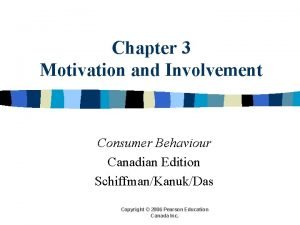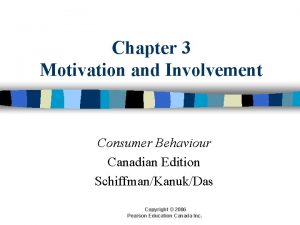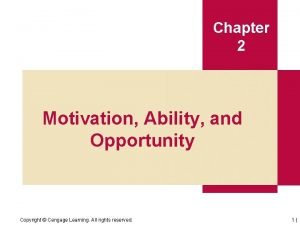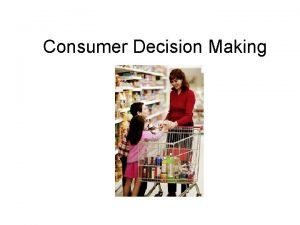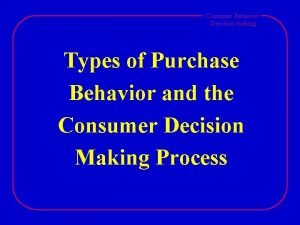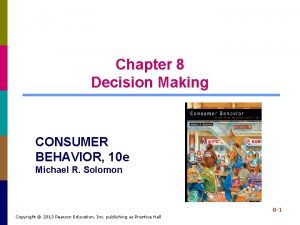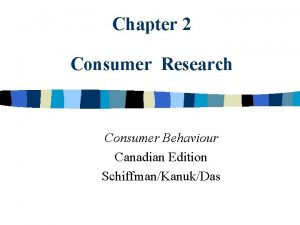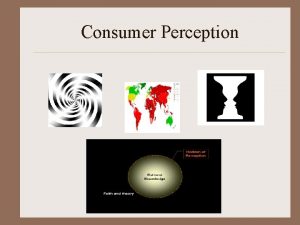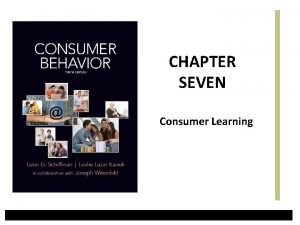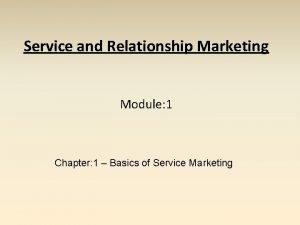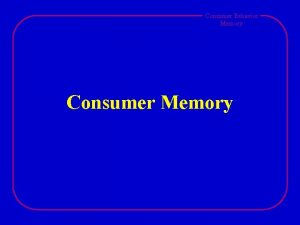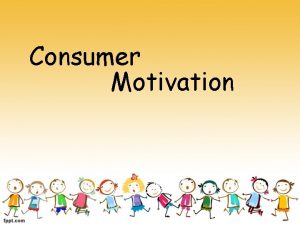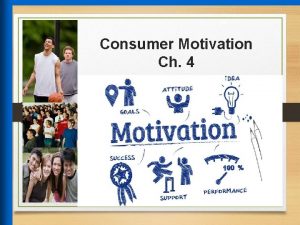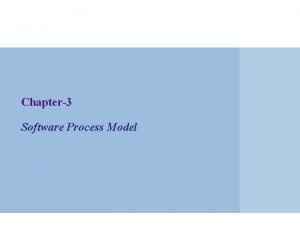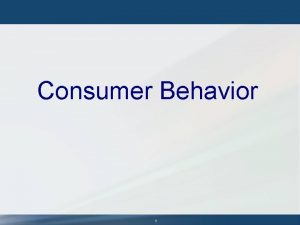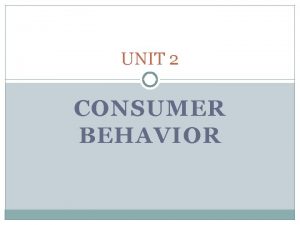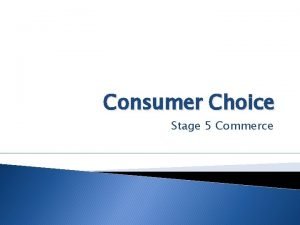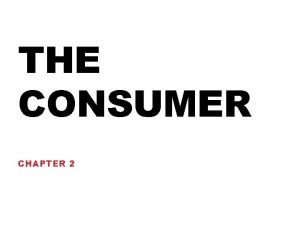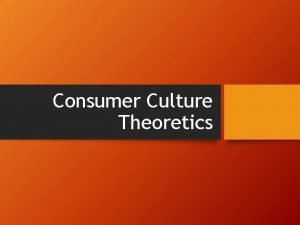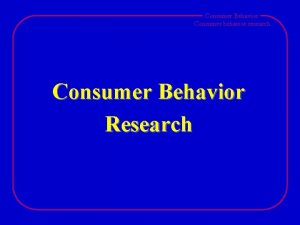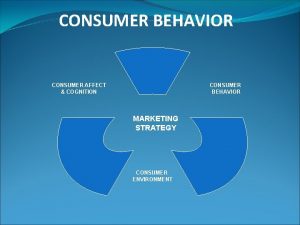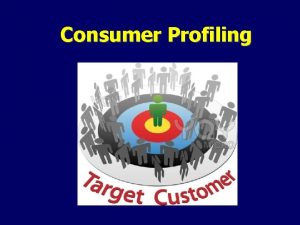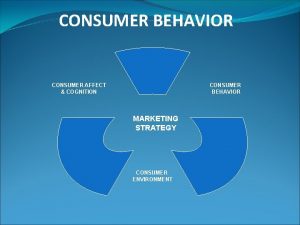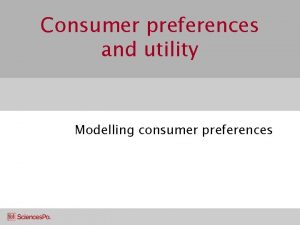Consumer Motivation OUTLINE Model of the Motivation Process





























- Slides: 29

Consumer Motivation • • • OUTLINE Model of the Motivation Process Goals Motives Needs Motivational Research Copyright 2007 by Prentice Hall 4 -1

Needs and Motivation • Needs are the essence of the marketing concept. Marketers do not create needs but can make consumers aware of needs. • Motivation is the driving force within individuals that impels them to action. Copyright 2007 by Prentice Hall 4 -2

Figure 4. 1 Model of the Motivation Process Copyright 2007 by Prentice Hall 4 -3

Types of Needs • Innate Needs – Physiological (or biogenic) needs that are considered primary needs or motives • Acquired Needs – Learned in response to our culture or environment. Are generally psychological and considered secondary needs Copyright 2007 by Prentice Hall 4 -4

Is a body spray an innate or acquired need? Copyright 2007 by Prentice Hall 4 -5

Goals • The sought-after results of motivated behavior • Generic goals are general categories of goals that consumers see as a way to fulfill their needs • Product-specific goals are specifically branded products or services that consumers select as their goals Copyright 2007 by Prentice Hall 4 -6

Figure 4 -2 a Goals Structure for Weight Control Copyright 2007 by Prentice Hall 4 -7

Figure 4 -2 b Goals Structure for Weight Control Copyright 2007 by Prentice Hall 4 -8

Figure 4 -2 c Goals Structure for Weight Control Copyright 2007 by Prentice Hall 4 -9

Weight Control Giants weblink Copyright 2007 by Prentice Hall weblink 4 - 10

The Selection of Goals • The goals selected by an individual depend on their: – Personal experiences – Physical capacity – Prevailing cultural norms and values – Goal’s accessibility in the physical and social environment Copyright 2007 by Prentice Hall 4 - 11

Discussion Question • What are three generic goals you have set for yourself in the past year? • What are three product-specific goals you have set in the past year? • In what situations are these two related? • How were these goals selected? Was it personal experiences, physical capacity, or prevailing cultural norms and values? Copyright 2007 by Prentice Hall 4 - 12

Motivations and Goals Positive • Motivation – A driving force toward some object or condition • Approach Goal – A positive goal toward which behavior is directed Copyright 2007 by Prentice Hall Negative • Motivation A driving force away from some object or condition • Avoidance Goal – A negative goal from which behavior is directed away 4 - 13

Rational versus Emotional Motives • Rationality implies that consumers select goals based on totally objective criteria such as size, weight, price, or miles per gallon • Emotional motives imply the selection of goals according to personal or subjective criteria Copyright 2007 by Prentice Hall 4 - 14

Discussion Question • What products might be purchased using rational and emotional motives? • What marketing strategies are effective when there are combined motives? Copyright 2007 by Prentice Hall 4 - 15

The Dynamic Nature of Motivation • Needs are never fully satisfied • New needs emerge as old needs are satisfied • People who achieve their goals set new and higher goals for themselves Copyright 2007 by Prentice Hall 4 - 16

Substitute Goals • Are used when a consumer cannot attain a specific goal he/she anticipates will satisfy a need • The substitute goal will dispel tension • Substitute goals may actually replace the primary goal over time Copyright 2007 by Prentice Hall 4 - 17

Frustration • Failure to achieve a goal may result in frustration. • Some adapt; others adopt defense mechanisms to protect their ego. Copyright 2007 by Prentice Hall 4 - 18

Defense Mechanism • Methods by which people mentally redefine frustrating situations to protect their self-images and their selfesteem Copyright 2007 by Prentice Hall 4 - 19

What type of defense mechanism is this spokesperson using in this ad? Copyright 2007 by Prentice Hall 4 - 20

Arousal of Motives • • Physiological arousal Emotional arousal Cognitive arousal Environmental arousal *See notes below Copyright 2007 by Prentice Hall 4 - 21

Maslow’s Hierarchy of Needs Figure 4. 10 weblink Copyright 2007 by Prentice Hall 4 - 22

Discussion Question • What are three types of products related to more then one level of Maslow’s Hierarchy of Needs. • For each type of product – consider two brands. How do marketers attempt to differentiate their product from the competition? Copyright 2007 by Prentice Hall 4 - 23

This ad reflects a need for accomplishment with a toothpaste. Copyright 2007 by Prentice Hall 4 - 24

A Trio of Needs • Power – individual’s desire to control environment • Affiliation – need for friendship, acceptance, and belonging • Achievement – need for personal accomplishment – closely related to egoistic and selfactualization needs Copyright 2007 by Prentice Hall 4 - 25

Measurement of Motives • Researchers rely on a combination of techniques • Combination of behavioral, subjective, and qualitative data • Construction of a measurement scale can be complex Copyright 2007 by Prentice Hall 4 - 26

Motivational Research • Qualitative research designed to uncover consumers’ subconscious or hidden motivations • Attempts to discover underlying feelings, attitudes, and emotions Copyright 2007 by Prentice Hall 4 - 27

Qualitative Motivational Research • Metaphor analysis • Storytelling • Word association and sentence completion • Drawing pictures and photo-sorts Copyright 2007 by Prentice Hall 4 - 28

Many Companies Specialize in Motivational Research weblink Copyright 2007 by Prentice Hall we blink 4 - 29
 Food chain vs food web
Food chain vs food web Herbivores in the sahara desert
Herbivores in the sahara desert Consumer diversity in consumer behaviour
Consumer diversity in consumer behaviour Consumer behaviour research process
Consumer behaviour research process Consumer markets and consumer buyer behavior
Consumer markets and consumer buyer behavior Types of buyer behavior
Types of buyer behavior Motivation in consumer behaviour
Motivation in consumer behaviour Consumer motivation
Consumer motivation Dynamic nature of motivation in consumer behaviour
Dynamic nature of motivation in consumer behaviour Cengage
Cengage Example of topic outline and sentence outline
Example of topic outline and sentence outline Consumer decision making process
Consumer decision making process Pre purchase evaluation of alternatives
Pre purchase evaluation of alternatives Decision making process consumer behavior
Decision making process consumer behavior Decision chapter 8
Decision chapter 8 Consumer research process
Consumer research process Consumer perception process
Consumer perception process Consumer learning process
Consumer learning process Buying decision process
Buying decision process Goods and services examples
Goods and services examples Hình ảnh bộ gõ cơ thể búng tay
Hình ảnh bộ gõ cơ thể búng tay Bổ thể
Bổ thể Tỉ lệ cơ thể trẻ em
Tỉ lệ cơ thể trẻ em Voi kéo gỗ như thế nào
Voi kéo gỗ như thế nào Tư thế worms-breton
Tư thế worms-breton Hát lên người ơi alleluia
Hát lên người ơi alleluia Môn thể thao bắt đầu bằng chữ f
Môn thể thao bắt đầu bằng chữ f Thế nào là hệ số cao nhất
Thế nào là hệ số cao nhất Các châu lục và đại dương trên thế giới
Các châu lục và đại dương trên thế giới







